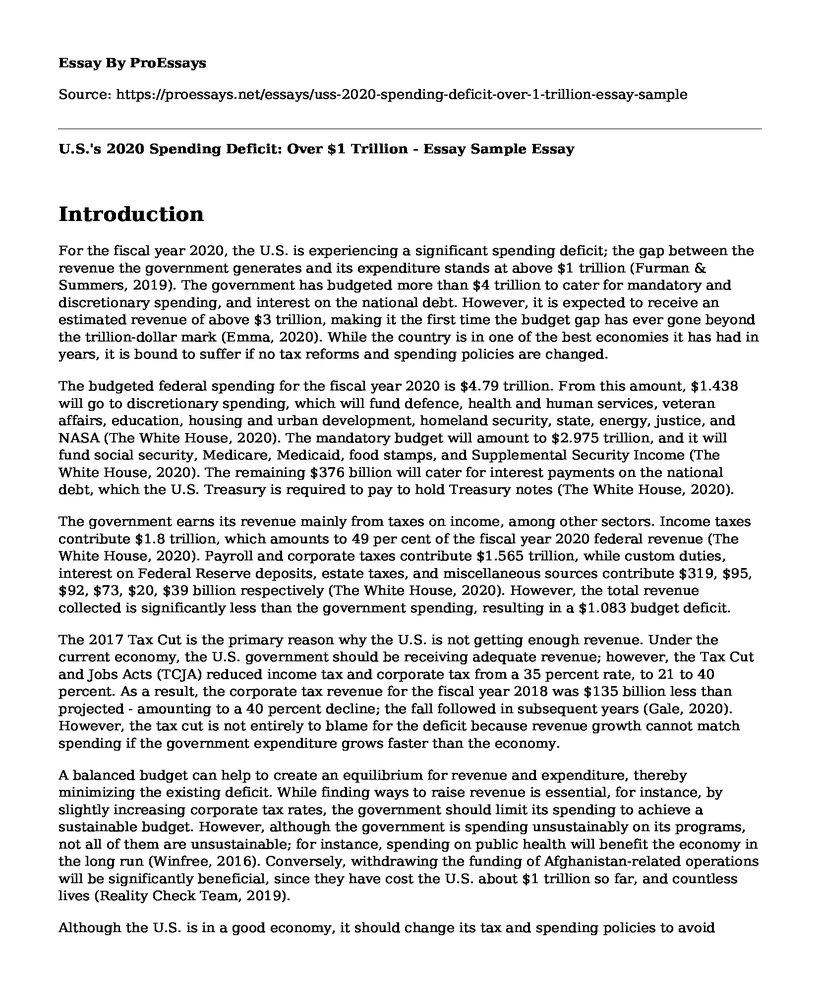Introduction
For the fiscal year 2020, the U.S. is experiencing a significant spending deficit; the gap between the revenue the government generates and its expenditure stands at above $1 trillion (Furman & Summers, 2019). The government has budgeted more than $4 trillion to cater for mandatory and discretionary spending, and interest on the national debt. However, it is expected to receive an estimated revenue of above $3 trillion, making it the first time the budget gap has ever gone beyond the trillion-dollar mark (Emma, 2020). While the country is in one of the best economies it has had in years, it is bound to suffer if no tax reforms and spending policies are changed.
The budgeted federal spending for the fiscal year 2020 is $4.79 trillion. From this amount, $1.438 will go to discretionary spending, which will fund defence, health and human services, veteran affairs, education, housing and urban development, homeland security, state, energy, justice, and NASA (The White House, 2020). The mandatory budget will amount to $2.975 trillion, and it will fund social security, Medicare, Medicaid, food stamps, and Supplemental Security Income (The White House, 2020). The remaining $376 billion will cater for interest payments on the national debt, which the U.S. Treasury is required to pay to hold Treasury notes (The White House, 2020).
The government earns its revenue mainly from taxes on income, among other sectors. Income taxes contribute $1.8 trillion, which amounts to 49 per cent of the fiscal year 2020 federal revenue (The White House, 2020). Payroll and corporate taxes contribute $1.565 trillion, while custom duties, interest on Federal Reserve deposits, estate taxes, and miscellaneous sources contribute $319, $95, $92, $73, $20, $39 billion respectively (The White House, 2020). However, the total revenue collected is significantly less than the government spending, resulting in a $1.083 budget deficit.
The 2017 Tax Cut is the primary reason why the U.S. is not getting enough revenue. Under the current economy, the U.S. government should be receiving adequate revenue; however, the Tax Cut and Jobs Acts (TCJA) reduced income tax and corporate tax from a 35 percent rate, to 21 to 40 percent. As a result, the corporate tax revenue for the fiscal year 2018 was $135 billion less than projected - amounting to a 40 percent decline; the fall followed in subsequent years (Gale, 2020). However, the tax cut is not entirely to blame for the deficit because revenue growth cannot match spending if the government expenditure grows faster than the economy.
A balanced budget can help to create an equilibrium for revenue and expenditure, thereby minimizing the existing deficit. While finding ways to raise revenue is essential, for instance, by slightly increasing corporate tax rates, the government should limit its spending to achieve a sustainable budget. However, although the government is spending unsustainably on its programs, not all of them are unsustainable; for instance, spending on public health will benefit the economy in the long run (Winfree, 2016). Conversely, withdrawing the funding of Afghanistan-related operations will be significantly beneficial, since they have cost the U.S. about $1 trillion so far, and countless lives (Reality Check Team, 2019).
Although the U.S. is in a good economy, it should change its tax and spending policies to avoid future economic crisis. The government primarily earns its revenue from taxes; hence, the 2017 tax cut resulted in a notable decline in the projected revenue. A balanced budget can help to achieve sustainability, by not only finding ways to increase revenue but also minimize expenditure. However, the government should limit its spending on programs that are hurting the economy, not sustainable ones like public health.
References
Emma, C. (2020, January 28). Federal Deficit to Top $1 Trillion under Trump. Politico. Retrieved from https://www.politico.com/amp/news/2020/01/28/federal-deficit-one-trillion-trump-107901
Furman, J., & Summers, L. H. (2019). Who's afraid of budget deficits? Foreign Affairs. Retrieved from https://www.law.nyu.edu/sites/default/files/Furman%20Jason%20Summers%20and%20Lawrence_2019_whos%20afraid%20of%20budget%20deficits_foreign%20affairs.pdf
Gale, G. W. (2020, February 14). Did the 2017 Tax Cut Pay for Itself? Brookings. Retrieved from https://www.brookings.edu/policy2020/votervital/did-the-2017-tax-cut-the-tax-cuts-and-jobs-act-pay-for-itself/
Reality Check team. (2019, August 29). Has the Afghan conflict cost the U.S. $500bn? Retrieved from https://www.bbc.com/news/world-47391821
The White House. (2020). The fiscal Year 2020 Budget of the U.S. Government. Retrieved from https://www.whitehouse.gov/wp-content/uploads/2019/03/budget-fy2020.pdf
Winfree, P. (2016). Causes of the Federal Government's Unsustainable Spending. Retrieved from https://www.heritage.org/budget-and-spending/report/causes-the-federal-governments-unsustainable-spending
Cite this page
U.S.'s 2020 Spending Deficit: Over $1 Trillion - Essay Sample. (2023, Apr 10). Retrieved from https://proessays.net/essays/uss-2020-spending-deficit-over-1-trillion-essay-sample
If you are the original author of this essay and no longer wish to have it published on the ProEssays website, please click below to request its removal:
- Research Paper on Hierarchical Market Entry Modes
- Paper Example on Drivers of Demand for Spotify Subscriptions
- Essay Example on Uniting the World: One World Order for a Safer World
- The Great Recession: US Automobile Industry's Bailout - Essay Sample
- Macroeconomics: Assessing Economies, Principles for Achieving Economic Goals - Essay Sample
- Paper Example on Amazon.com: Global Giant in Retail E-commerce, CSR Commitment Questioned
- Globalization's Impact: Netflix's Strategies for Success - Free Essay Sample







